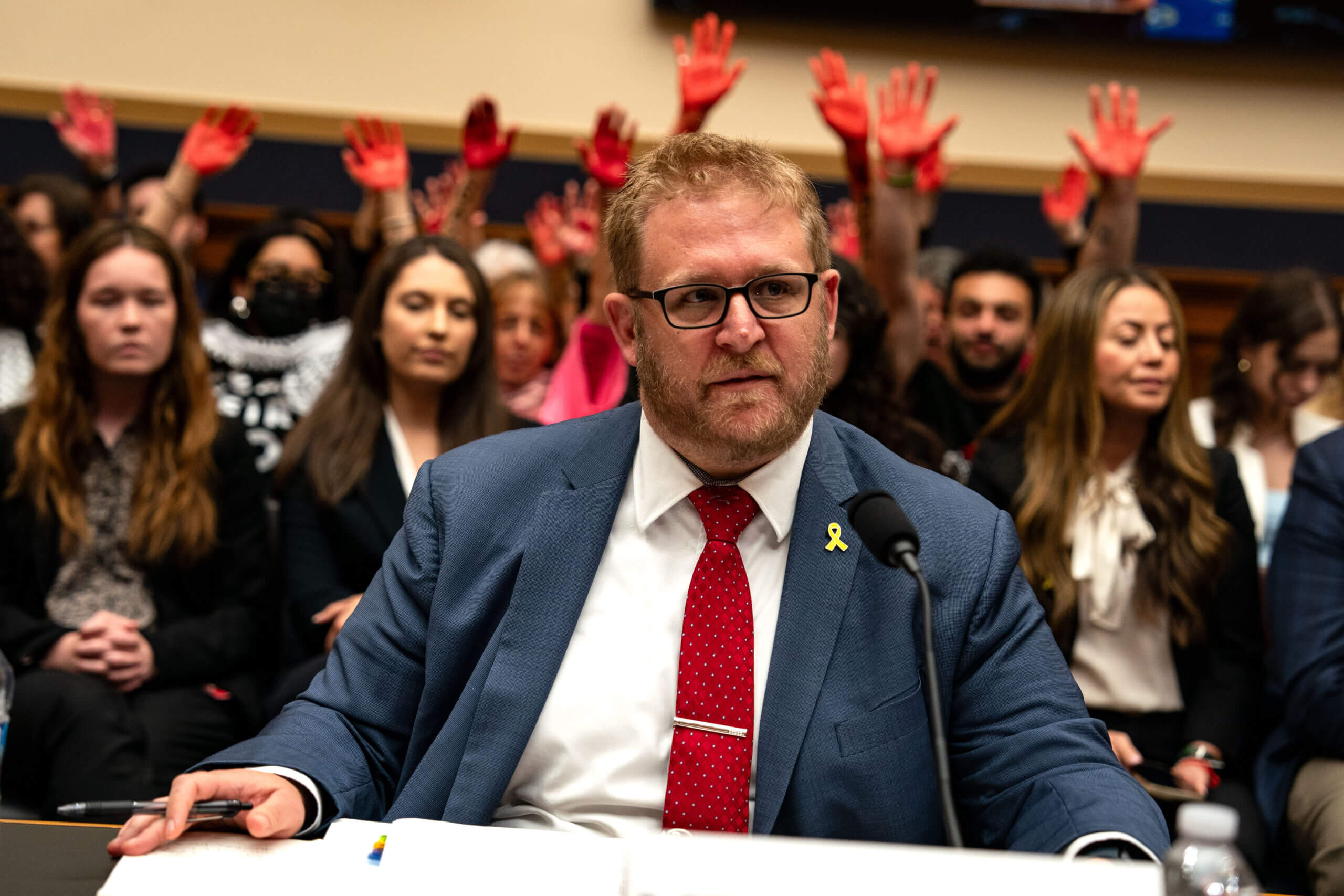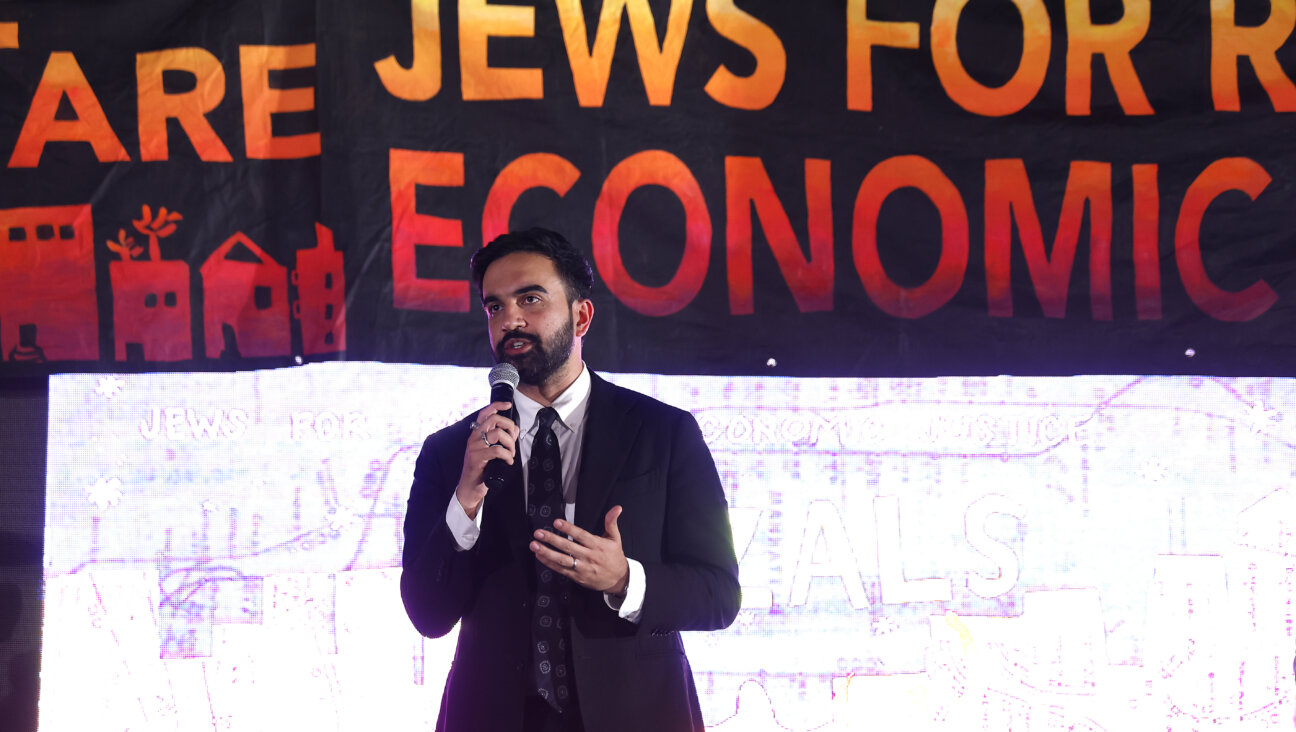Project Esther created a blueprint for Trump to fight antisemitism. The ‘Shofar Report’ is a liberal response.
The report argues that strengthening democratic institutions — and countering the ‘weaponization’ of antisemitism — is the best way to protect Jews

A woman holds a sign supporting Jewish students during a rally against campus antisemitism at George Washington University on May 2, 2024. Photo by Andrew Harnik/Getty Images
Most American Jews have taken a dim view of the Trump administration’s approach to fighting antisemitism, saying his policies are disingenuous and prone to exacerbate the problem rather than solve it.
But beyond rejecting the crackdown on universities, liberal Jews have lacked a singular blueprint for fighting antisemitism akin to what the conservative Heritage Foundation offered the Trump administration with Project Esther.
The Nexus Project is hoping to change that with Tuesday’s release of the Shofar Report, a 63-page document that combines policy recommendations with essays arguing that leaders interested in countering antisemitism should focus on strengthening democratic institutions.
Its authors hope that it will fill a vacuum for both politicians and individual Jewish Americans.
“People are really hungry for solutions,” said Amy Spitalnick, chief of the Jewish Council for Public Affairs. “They’re frustrated by the false choice of either protecting democracy or countering antisemitism.”
Spitalnick’s organization has been one of the leading voices alongside Nexus in arguing that the Trump administration’s moves to deport student protesters and cancel grants to universities accused of antisemitism are endangering Jews by weakening American democracy.
“We’re saying fighting the weaponization of antisemitism is a strategy for fighting antisemitism.”Jonathan JacobyNational director of the Nexus Project
The Shofar Report builds on these arguments with a set of nine key recommendations focused on funding educational initiatives and civil rights protection while avoiding limits on free speech by directing enforcement at “clear discrimination and harassment.”
It calls for providing universities with more resources to combat harassment toward Jews, teaching more about the Holocaust and expanding investments in programs that help people leave extremist movements.
John Ruskay, the former director of UJA-Federation of New York, said that the Shofar Report comes at a time when Jewish leaders have poured resources into fighting antisemitism, often without much basis in data or a cohesive strategy and that could help “those who want to go beyond sloganizing.”
It also serves as counterprogramming to Project Esther, released by the Heritage Foundation shortly before last year’s presidential election with advice for how a future Trump administration should fight antisemitism. The document described a “Hamas Support Network” (composed of progressive nonprofits and foundations) threatening Jews that could be dismantled by the federal government.
Jonathan Jacoby, the national director of Nexus, said that the Shofar Report’s narrative is that there is no tension between protecting civil liberties and countering antisemitism. “People think that we need to fight antisemitism and then, as a separate matter, you need to fight the weaponization of antisemitism,” he said. “And we’re saying fighting the weaponization of antisemitism is a strategy for fighting antisemitism.”

Nexus, which expanded from an academic task force focused on defining antisemitism into a full-fledged advocacy organization in 2024, quickly gained influence with the Biden administration and among Democrats in Congress who were looking for advice on how to respond to increasingly illiberal policy recommendations around antisemitism put forth by both Republicans and legacy Jewish organizations like the Anti-Defamation League.
Rep. Jerry Nadler, the New York Democrat, has become a champion of Nexus’ approach, which focuses as much on concern for freedom of expression as on raising the alarm about antisemitism itself. He praised Tuesday’s report in a statement, saying it “highlights some of the most timely and acute challenges facing the Jewish community and American democracy today.”
The second half of the report, which was edited by Forward opinion columnist Emily Tamkin, features longer essays by academics seeking to contextualize the contemporary conversation around antisemitism for Jewish clergy and lay leaders trying to guide their communities.
The Shofar Report’s reliance on so many authors can muddle its message around the line between legitimate criticism of Israel and antisemitism — arguably the central question in today’s debates.
Rabbi Seth Limmer, for example, kicks off the policy briefs by focusing on the protests that followed the Oct. 7 Hamas terrorist attack, and dwells on other quandaries coming from progressives, like the absence of Jewish studies experts at the University of Chicago’s Department of Race, Diaspora and Indigeneity.
But a few pages later, David Myers, a professor at the University of California, Los Angeles, offers a forceful defense of higher education. He writes that the threat to Jews at universities comes from “new attempts to silence protesters in the name of protecting Jews.”
The varied perspectives add weight to what Jacoby said was an attempt to create a document that could transcend traditional partisan lines, and Limmer said his hope is that readers understand the need for a holistic approach to the problem: “It is definitely time for a new conversation around antisemitism that removes this fictitious partisan divide that pretends like only some people are responsible for the problem.”
While the report offers a detailed diagnosis of what it refers to as “authoritarian shortcuts” — in one section, Judith Lichtman, a civil rights attorney, assails “attacks on nonprofits under the guise of fighting terrorism” — many of its recommendations lack specificity. Lichtman, for instance, calls for Congress to “address white supremacy in law enforcement,” but does not detail how lawmakers should do so.
Project Esther’s public report also included somewhat vague pieces of advice to the executive branch, though these were partially fleshed out in private donor presentations created by the Heritage Foundation that detailed the mechanics of pressuring universities and civil society groups.
Other recommendations in the Shofar Report include expanding media literacy programs to help students recognize conspiracy theories, incorporating Jewish content into school curricula and supporting partnerships between Jews and other minority groups. Some of its more concrete policy recommendations — like fully funding the Education Department’s civil rights office, which is less than half the size it was at the start of 2025 and being is further reduced during the government shutdown — seem almost certain to be nonstarters so long as President Donald Trump is in office.
Jacoby acknowledged that the Shofar Report is being released at a time when Democrats, who are more likely to be receptive to its perspective, are out of power and focused on responding to actions from the White House rather than driving their own policy agenda.
“This is a plan for the present, not for the future,” Jacoby said. “We’ll work on that next.”

















